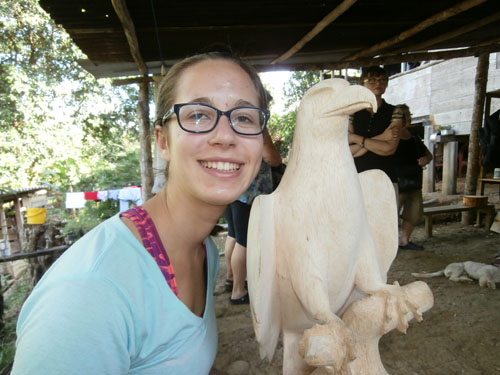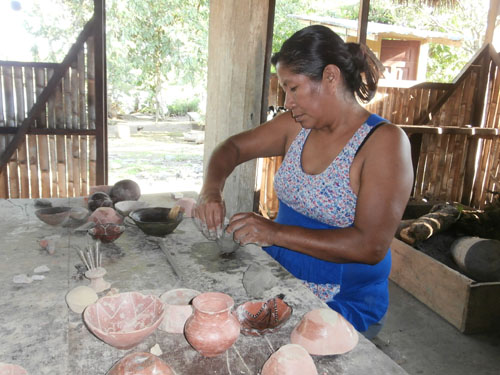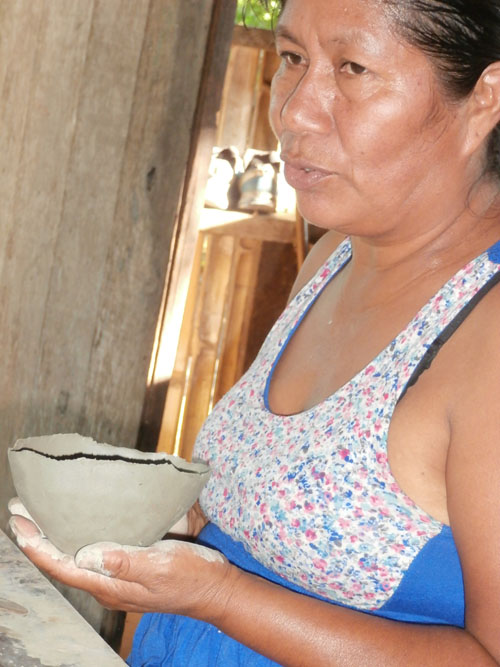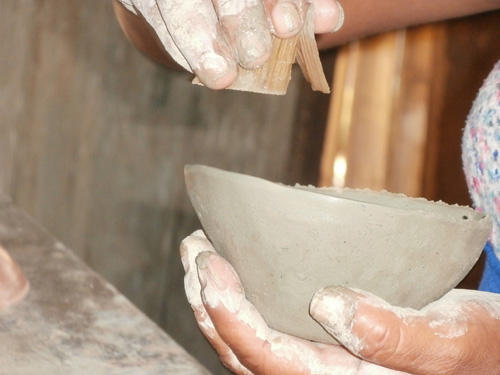
|
I visited my daughter, Hilary, who is studying abroad this semester in Quito, Ecuador. We went to La Casa de Suizo, along the Napo River in the rainforest of eastern Ecuador. In addition to beautiful nature walks, delicious food, and a visit to an animal rescue center, we had the opportunity to visit an indigenous Quechua village. There we met friendly locals who taught us about their artisanal handcrafts.  Carving a falcon in wood takes a whole day. With a machete, Samuel rapidly swats at the soft, light balsam wood to create the general shape of a falcon. Once he has arrived at the rough shape, he switches to a carving knife. Seated, Samuel hunches over the balsam wood, which rests on the trunk pedestal. The wood is so soft and light that he almost effortlessly carves the beak, the claws, and the body of the falcon. After being baked to remove moisture from the wood, the carving is painted. Upstairs, you can purchase some of his art.  Ceramics is the work of mujeres — women, whose craft is taught when they are young girls. Wearing pink flip-flops and a floral tank top, Lourdes sits at a small wooden table and explains in Spanish her Quechua background and the importance of ceramics to the Quechua culture. Dipping her fingers in muddy water, she grabs a clump of gray clay (only small quantities of clay can be dug at one time from the nearby riverbanks).  She pats it back and forth between her hands to form a ball and then rolls it on the table to create a coil, tapping each end to flatten it. Then she rolls out another clay coil. Next she pokes a hole into the main ball and squeezes and presses the sides to form a very thin bowl. She wraps one coil along the top rim and squeezes and pinches it to adhere it to the bowl's rim. Then she attaches the second coil.  Once the bowl has dried, but before it has been fired, Lourdes dips a rock made of hardened colored clay in water and demonstrates the painting of red or black hues on the bowl. Using minuscule brushes made from black human hair, she paints intricate geometric patterns. After each cup air-dries for one day, to prevent cracking, it is placed on a handmade rack and baked over an open fire in the corner of the same room. You can purchase some of Lourdes' creations — $3 for a tiny bowl to $25 for larger, more intricately painted bowls. Exact change is much appreciated, as change is hard to obtain in Ecuador.  Posted By Karen Axelrod Nov 25, 2015
|
Archives2019 2018 2017 2016 2015 2014 2013 2012 2011 2010 2009 2008 2007 |